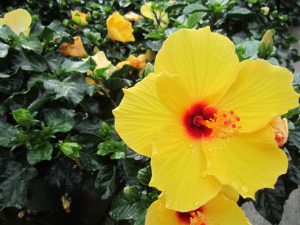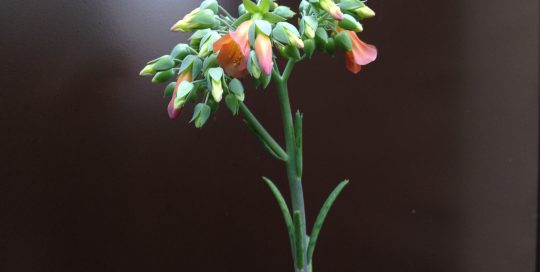Tips for Growing Tropical Hibiscus
Views: 7825

Many people purchase tropical hibiscus plants this time of year to brighten up their porches and patios. These reliable bloomers come in shades of yellow, pink, red, and orange, as well as several bicolor varieties. They are sold in bush form or as standards (small tree form), sometimes with a braided trunk.
With their glossy foliage and large bright flowers, they are the perfect plant to use in containers to brighten up a sunny spot at your home. Here are a few care tips to keep your Hibiscus happy and blooming.
Slowly Introduce Tropical Hibiscus
If the plant you purchased was in a greenhouse or other protected environment and you intend to place it in full sun (6 or more hours of direct sunlight), slowly introduce it to its new home by keeping it in full sun for a couple of hours the first day, then gradually increasing this amount of time over the course of a week or so. This will help reduce the shock of being taken from a sheltered environment and immediately placed in a hot and sunny location.
If you don’t have time for this, don’t worry about it. The plant will likely show some signs of stress at first, but will recover quickly with proper care.
Water Consistently
Hibiscus, like most plants, prefer consistent watering and react poorly to consistently wet or dry conditions. Too wet encourages disease and rot while too dry shuts down bloom production and will eventually kill the plant or it will take a long time to recover. To prevent this, use quality potting soil and only water when soil feels dry to the touch.
Use a Fertilizer High in Potassium
Hibiscus are heavy feeders, but unlike most flowering plants, they prefer a fertilizer with a high amount of Potassium (K, or the last number), rather than Phosphorous (P, or the middle number).
Look for a fertilizer with ratio numbers like 8-4-12. During the growing season, feed weekly with a diluted water-soluble mix or add slow-release granular fertilizer to the potting mix at planting and then reapply according to the manufacturer’s recommendations.
Control Temperature
Hibiscus performs best in temperatures between 75 and 85 degrees Fahrenheit. Some afternoon shade helps in climates that get hotter than this.
Hibiscus may be overwintered indoors, but will likely drop all of their leaves and quit blooming in anything short of a balmy greenhouse. Before the first frost, move the plant indoors to the brightest location possible and keep the soil moist (not wet!). Keep an eye out for insects and treat as soon as possible to avoid further stressing the plant. Move back outside in spring once any chance of frost is past.
Watch for Tropical Hibiscus Pests
Hibiscus are most susceptible to aphids, mites, and whiteflys, although other insect problems may occur. A good stream of water sprayed wherever insects are located is often enough to control the problem. If more drastic methods are needed to control insects, first try spraying insecticidal soap or a couple tablespoons of dishwashing soap per gallon of water before trying harsher chemical insecticides.
Never spray your plants during the heat of the day, as this will scorch the leaves.
Japanese beetles enjoy chewing on Hibiscus, especially buds and blooms. The best control is to hand pick beetles off the plant early in the morning when they aren’t active. Drop the beetles in a bucket of soapy water to kill them.
Meet Abbi Hayes
Abbi's Recent Posts

Kalanchoe delagoensis: Mother of Millions







